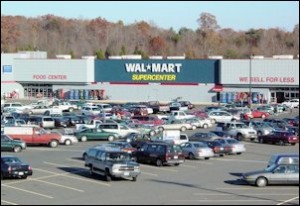by James A. Bacon
Lefty Smart Growthers loathe big box stores, none more so than Wal-Mart. The big boxes are ugly as sin, they (allegedly) oppress their workers, they perpetuate dysfunctional, auto-centric human settlement patterns and they drive small, independent merchants out of business. If only there were a way to legislate them out of business!
Two decades ago, urbanists in the United Kingdom, hoping to preserve “town center vitality” from the effect of big-box stores, decided to do something. They enacted planning guidelines in 1993 and 1996 that created significant restrictions on large stores (more than 1,000 square meters) not located in town centers. In one respect, the restrictions worked as planned — they led to a reduction in the opening of large retail stores. In other respect, they failed — they accelerated the demise of small, independent merchants. Another case of the law of unintended consequences.
Top-down social engineers are not always liberals and progressives; in the U.K. local Conservative Party officials also cracked down on big-box stores. Whatever their partisan affiliation, good-government zealots are often wrong but never in doubt. Rarely do they pause to measure results and see if what they’re doing is actually working. Fired up with noble intentions, they just plunge ahead with their next meddlesome scheme.
Fortunately, Rafaella Sadun, now on the faculty of the Harvard Business School, chose as part of her research dissertation to examine the consequences of the U.K. big-box regulations. Sadun tracked the number of U.K. planning grants and retail establishments in 303 local planning authorities between 1993 and 2004, before and after the regulations went into effect. Her conclusion in “Does Planning Regulation Protect Independent Retailers“: “Independent retailers were actually harmed by the creation of entry barriers against large shops.”
However did the good intentions boomerang? Well, it seems that the big retailers altered their behavior in a way that the goo-goos had not anticipated. “Instead of simply reducing the number of new large stores entering a market, entry regulations created the incentive for large retail chains to invest in smaller and more centrally located formats, which competed more directly with independents and accelerated their decline.”
Sadun’s statistical analysis suggests that planning deform accounted for between 4% and 22% of the increase in smaller-store formats opened by large chains and between 6% and 26% of the decline in employment by independent retailers.
Oops.
Bacon’s bottom line: I’m no fan of big-box stores but I have a different philosophy. Rather than trying to regulate them out of existence, I would prefer simply to stop subsidizing them directly (through tax breaks and incentives) or indirectly (by supplying low-cost infrastructure). Create a level playing field, then butt out. Big retailers enjoy economies of scale in their supply chains, which drive down costs. Small merchants enjoy a closer relationship with their customers, and they tend to thrive in walkable, bikable settings where big-box formats don’t work. Meanwhile, new technologies are entering the marketplace that allow retailers to gather data on customer shopping patterns within their stores, deliver customized marketing pitches direct to shoppers’ smart phones, and create buzz through social media. There is absolutely no way to predict how this will all shake out, and it is certifiably insane for planners or the goo-goos who flog them forward to pick winners and losers.
The Smart Growth conservative’s position on big-box stores: stop subsidizing them, create a level playing field with small retailers and step aside. By all means, root for the little guy. But let the marketplace decide winners and losers.
(Hat tip: Emily Badger, Atlantic Cities blog.)



